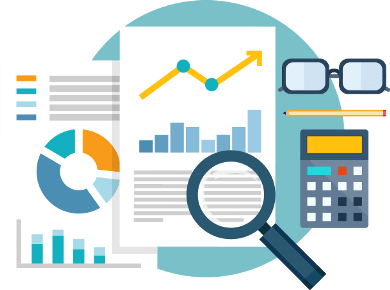 Analyzing the data for your doctoral dissertation is a critical step in conducting meaningful research. To ensure accurate and insightful results, researchers often rely on powerful tools such as SPSS (Statistical Package for the Social Sciences). SPSS offers a wide range of features and functionalities specifically designed for analyzing complex data sets. However, effectively utilizing SPSS requires a structured approach and a thorough understanding of its capabilities. We are here to explore how you can analyze data with the help of SPSS software. We will cover essential steps, including data preparation, descriptive statistics, exploratory data analysis, hypothesis testing, data transformation, reporting and interpretation, data visualization, collaboration, and documentation, as well as seeking help and resources. By following the guidelines we have outlined, researchers can harness the full potential of SPSS, ensuring accurate analysis of data with SPSS and meaningful insights for their doctoral dissertation research. Whether you are a beginner or an experienced researcher, mastering the best practices for SPSS analysis will empower you to make informed decisions and contribute valuable knowledge to your field of study.
Analyzing the data for your doctoral dissertation is a critical step in conducting meaningful research. To ensure accurate and insightful results, researchers often rely on powerful tools such as SPSS (Statistical Package for the Social Sciences). SPSS offers a wide range of features and functionalities specifically designed for analyzing complex data sets. However, effectively utilizing SPSS requires a structured approach and a thorough understanding of its capabilities. We are here to explore how you can analyze data with the help of SPSS software. We will cover essential steps, including data preparation, descriptive statistics, exploratory data analysis, hypothesis testing, data transformation, reporting and interpretation, data visualization, collaboration, and documentation, as well as seeking help and resources. By following the guidelines we have outlined, researchers can harness the full potential of SPSS, ensuring accurate analysis of data with SPSS and meaningful insights for their doctoral dissertation research. Whether you are a beginner or an experienced researcher, mastering the best practices for SPSS analysis will empower you to make informed decisions and contribute valuable knowledge to your field of study.
Guidelines for using SPSS for the analysis of doctoral dissertation data;
- Data Preparation: Ensure that your data is well-prepared and organized whereby you can start with importing your data into SPSS, ensuring that each variable is correctly labeled. Create a data dictionary to document the variables, their definitions, and coding schemes as well as check for missing values, outliers, and any inconsistencies in the data. We can help in cleaning and preparing your data meticulously to save you time and prevent errors during analysis.
- Descriptive Statistics: This helps in gaining a comprehensive understanding of your data as SPSS provides a range of descriptive statistics, including measures of central tendency (mean, median, mode) and dispersion (standard deviation, variance). These statistics will help you identify the distribution of variables, detect outliers, and assess the overall quality of your data.
- Exploratory Data Analysis: To uncover meaningful patterns and relationships within your data, perform exploratory data analysis (EDA) since there are various tools and techniques for EDA in SPSS, such as histograms, scatterplots, and correlation matrices. These visualizations will allow you to identify trends, associations, and potential outliers gaining valuable insights that can inform your research questions and hypotheses.
- Hypothesis Testing: SPSS provides a wide range of statistical tests to examine relationships and differences between variables. Whether you need to perform t-tests, chi-square tests, ANOVA, or regression analysis, SPSS has the tools to assist you. To show you the best way to use SPSS to analyze doctoral dissertation data, we carefully select the appropriate statistical tests based on your research questions and hypotheses.
- Data Transformation: In some cases, you may need to transform your data to meet the assumptions of certain statistical tests or to make the interpretation easier and SPSS offers a variety of data transformation options, such as logarithmic transformations, standardization, or recoding variables. Before applying any transformations, make sure you understand their implications and consult our relevant literature or statistical experts if needed.
- Reporting and Interpretation: Once you have conducted your analyses, it's time to report and interpret the results as SPSS provides output tables and charts that summarize the statistical analyses performed. Take the time to understand and interpret these outputs correctly to clearly explain the findings in the context of your research questions and hypothesis. We emphasize supporting your interpretations with appropriate statistical evidence and considering any limitations or alternative explanations.
- Data Visualization: Create clear and visually appealing charts, graphs, and plots that highlight the key results of your analysis which will help your readers grasp the main findings of your research quickly and enhance the overall impact of your dissertation.
- Collaboration and Documentation: If you are working as part of a research team or under the guidance of a supervisor, collaboration, and documentation are essential which is possible since SPSS allows you to save and share your analysis files, making it easier to collaborate and receive feedback. Maintain thorough documentation of your analysis steps, including the syntax used in SPSS which will not only ensure transparency but also help you replicate and validate your findings in the future.
- Seek Help and Resources: While SPSS is a powerful tool, it can be complex, especially if you are new to statistical analysis thus don't hesitate to seek help from your advisors, colleagues, or online resources. There are numerous tutorials, forums, and textbooks available that can guide you through various analysis techniques and SPSS functionalities.
Utilizing SPSS effectively is crucial when analyzing data for your doctoral dissertation. By following the best practices we have outlined above and seeking help from our proficient SPSS experts, you can ensure accurate, reliable, and meaningful results. Remember to carefully prepare and clean your data, perform descriptive and exploratory analysis, choose the appropriate statistical tests, interpret your findings accurately, and effectively visualize and report your results. With the right approach and SPSS's powerful capabilities, you can confidently analyze your dissertation's data and contribute valuable insights to your field of study.
Doctoral Dissertation Data Analysis Using SPSS – Credible Help
 Doctoral dissertations entail rigorous research and analysis, and data analysis plays a fundamental role in deriving meaningful insights. Among the various tools available, SPSS (Statistical Package for the Social Sciences) has gained popularity as a go-to data analysis software for dissertations at the doctoral level. Let us explore the use of SPSS in the analysis of collected data, focusing on different analysis types, the advantages it offers, and the main types of variables that can be analyzed using SPSS. Researchers doing a doctoral dissertation often require a comprehensive and user-friendly tool to analyze their data effectively. SPSS provides a wide range of analysis techniques, such as descriptive, inferential, and exploratory data analysis, which enable researchers to look into their data and extract valuable insights. These techniques facilitate the examination of relationships, the testing of hypotheses, and the exploration of patterns and trends within the data. The software offers several advantages for data analysis, including its intuitive graphical interface, extensive data preparation capabilities, a broad array of analytical techniques, and customizable output options as well as accommodates different types of variables, including continuous, categorical, and ordinal, allowing researchers to analyze their data comprehensively and draw robust conclusions. By utilizing SPSS for the analysis process, doctoral researchers can leverage its features and functionalities to conduct rigorous and insightful analyses, contributing to the advancement of knowledge in their respective fields.
Doctoral dissertations entail rigorous research and analysis, and data analysis plays a fundamental role in deriving meaningful insights. Among the various tools available, SPSS (Statistical Package for the Social Sciences) has gained popularity as a go-to data analysis software for dissertations at the doctoral level. Let us explore the use of SPSS in the analysis of collected data, focusing on different analysis types, the advantages it offers, and the main types of variables that can be analyzed using SPSS. Researchers doing a doctoral dissertation often require a comprehensive and user-friendly tool to analyze their data effectively. SPSS provides a wide range of analysis techniques, such as descriptive, inferential, and exploratory data analysis, which enable researchers to look into their data and extract valuable insights. These techniques facilitate the examination of relationships, the testing of hypotheses, and the exploration of patterns and trends within the data. The software offers several advantages for data analysis, including its intuitive graphical interface, extensive data preparation capabilities, a broad array of analytical techniques, and customizable output options as well as accommodates different types of variables, including continuous, categorical, and ordinal, allowing researchers to analyze their data comprehensively and draw robust conclusions. By utilizing SPSS for the analysis process, doctoral researchers can leverage its features and functionalities to conduct rigorous and insightful analyses, contributing to the advancement of knowledge in their respective fields.
Advantages of using SPSS for analyzing doctoral dissertation data;
- User-Friendly Interface: It offers a user-friendly interface that requires minimal programming knowledge, making it accessible to researchers from various disciplines. Its intuitive graphical interface enables researchers to import, manipulate, and analyze data efficiently, even without extensive statistical expertise.
- Extensive Data Preparation Capabilities: SPSS provides a range of features for data preparation, including data cleaning, transformation, and recoding thus researchers can easily handle missing data, outliers, and categorical variables, ensuring the data is appropriately prepared for analysis.
- Broad Array of Statistical Techniques: The program encompasses a wide range of techniques for doctoral dissertation data analysis using SPSS, making it suitable for diverse research domains whereby researchers can conduct basic descriptive analysis, inferential tests, multivariate analysis, and advanced modeling techniques, catering to the specific needs of their work.
- Output and Visualization Options: SPSS software generates comprehensive output reports, which include statistical summaries, tables, charts, and graphs, all customizable, enabling researchers to present their findings in a visually appealing and comprehensible manner.
What to consider when analyzing data for a doctoral dissertation in SPSS;
Analyzing data for any doctoral dissertation in the SPSS program is a critical and complex process that requires careful consideration of several key factors. First start by thoroughly understanding your research objectives and hypotheses and clearly define your research questions and the variables you intend to analyze. This foundational step is crucial as it will guide your entire process. Prepare your data which involves cleaning and organizing your data, checking for missing values, outliers, and inconsistencies to ensure that your data is in the correct format for SPSS analysis, including numeric and categorical variables. Ensure you select the appropriate statistical techniques that depend on the nature of your data and research questions, you may need to choose between descriptive statistics, inferential statistics, regression analysis, factor analysis, or other advanced methods. Be sure that the chosen methods align with your research objectives. Make sure that your sample is representative of the population you are studying and that it provides sufficient statistical power to detect meaningful effects or relationships. Be aware of the assumptions underlying your chosen statistical tests and check for violations. Interpreting the results is equally important hence the need to understand the output generated by SPSS and make sure you can explain the implications of your findings in the context of your research questions. Visual aids, such as charts and graphs, can help present your results effectively. Be mindful of ethical considerations and data privacy when working with human subjects data to ensure that your data collection and analysis procedures adhere to ethical standards and legal regulations. This process requires a systematic approach, from understanding your research objectives to data preparation, selecting appropriate statistical methods, and interpreting results. Attention to detail and adherence to ethical principles are fundamental throughout the process to ensure the validity and rigor of your research.
What are the main variables in SPSS dissertation data analysis?
- Continuous Variables: These are numeric variables that can take any value within a specific range. Examples include age, height, and income and SPSS offers various statistical techniques, such as correlation analysis and regression, to analyze the relationships and patterns within continuous variables.
- Categorical Variables: They represent characteristics or attributes that can be grouped into distinct categories. Illustrations include gender, education level, and occupation and SPSS allows researchers to perform frequency analysis, cross-tabulations, and chi-square tests to explore the relationships and differences between categorical variables.
- Ordinal Variables: Variables that possess a natural order or hierarchy between their categories which include Likert scale responses, educational attainment levels, or rankings hence SPSS provides techniques like non-parametric statistical tests and ordinal regression to analyze and interpret ordinal variables accurately.
SPSS has become an invaluable tool for data analysis regarding doctoral dissertations. Its diverse range of analysis types, user-friendly interface, extensive data preparation capabilities, and output customization options make it a preferred choice among researchers. It accommodates different types of variables, including continuous, categorical, and ordinal, allowing researchers to analyze their data comprehensively. By leveraging the advantages of SPSS, doctoral researchers can gain meaningful insights, draw accurate conclusions, and contribute to their respective fields with robust data analysis.






 NB: Sometimes we need to first assess your work to quote accordingly. Equally we may highlight a service input review on your placed order to confirm if the paid amount is
NB: Sometimes we need to first assess your work to quote accordingly. Equally we may highlight a service input review on your placed order to confirm if the paid amount is
